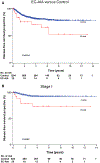Endometrial cancer arising in adenomyosis versus endometrial cancer coexisting with adenomyosis: are these two different entities?
- PMID: 28444512
- PMCID: PMC7523234
- DOI: 10.1007/s00404-017-4375-z
Endometrial cancer arising in adenomyosis versus endometrial cancer coexisting with adenomyosis: are these two different entities?
Abstract
Purpose: While adenomyosis is one of the most common benign histologic findings in hysterectomy specimens of endometrial cancer, demographics of endometrial cancer arising in adenomyosis (EC-AIA) has not been well elucidated. The aim of this study is to evaluate histopathological findings and disease-free survival (DFS) of EC-AIA in comparison to endometrial cancer coexisting with adenomyosis (EC-A).
Methods: EC-AIA cases were identified via a systematic literature search (n = 46). EC-A cases were identified from a historical cohort that underwent hysterectomy-based surgical staging in two institutions (n = 350). Statistical comparisons of the two groups were based on univariate and multivariate analyses.
Results: The EC-AIA group was significantly older than the EC-A group (58.9 versus 53.8, p = 0.002). As to tumor characteristics, 63.6% of EC-AIA cases reported tumor within the myometrium without endometrial extension. The EC-AIA group was significantly associated with more non-endometrioid histology (23.9 versus 14.8%; p = 0.002) and deep myometrial tumor invasion (51.6 versus 19.4%; p < 0.001) than EC-A. Tumor grade, stage, and nodal metastasis risk were similar (all, p > 0.05). In a univariate analysis, the EC-AIA group had a significantly decreased DFS compared to EC-A (5-year rates, 72.2 versus 85.5%, p = 0.001). After controlling for age, histology, tumor grade, and stage, EC-AIA remained an independent prognostic factor associated with decreased DFS compared to EC-A (adjusted-hazard ratio 2.87, 95% confidence interval 1.44-5.70, p = 0.031).
Conclusion: Our study demonstrated that EC-AIA has distinct tumor characteristics and a poorer survival outcome compared to EC-A. This suggests a benefit of recognition of this unique entity as an aggressive variant of endometrial cancer.
Keywords: Adenomyosis; Endometrial cancer; Endometriosis-associated cancer; Prognosis; Survival.
Conflict of interest statement
Figures


Similar articles
-
Tumor Characteristics and Survival Outcome of Endometrial Cancer Arising in Adenomyosis: An Exploratory Analysis.Ann Surg Oncol. 2016 Mar;23(3):959-67. doi: 10.1245/s10434-015-4952-y. Epub 2015 Nov 5. Ann Surg Oncol. 2016. PMID: 26542589 Free PMC article.
-
Significance of adenomyosis on tumor progression and survival outcome of endometrial cancer.Ann Surg Oncol. 2014 Dec;21(13):4246-55. doi: 10.1245/s10434-014-3880-6. Epub 2014 Jul 8. Ann Surg Oncol. 2014. PMID: 25001096
-
The clinicopathological characteristics and survival outcomes of endometrial carcinoma coexisting with or arising in adenomyosis: A pilot study.Sci Rep. 2020 Apr 6;10(1):5984. doi: 10.1038/s41598-020-63065-w. Sci Rep. 2020. PMID: 32249826 Free PMC article.
-
Whether surgical procedure can improve the prognosis of endometrial cancer arising in adenomyosis (EC-AIA)? A systematic review and meta-analysis.Int J Surg. 2024 May 1;110(5):3072-3080. doi: 10.1097/JS9.0000000000001234. Int J Surg. 2024. PMID: 38445439 Free PMC article.
-
Histological Prognostic Factors of Endometrial Cancer in Patients with Adenomyosis: A Systematic Review and Meta-Analysis.Pathobiology. 2022;89(3):127-134. doi: 10.1159/000521105. Epub 2022 Jan 20. Pathobiology. 2022. PMID: 35051948
Cited by
-
Endometrial cancer arising from adenomyosis: Case report and literature review of MRI findings.Radiol Case Rep. 2020 Feb 13;15(4):427-430. doi: 10.1016/j.radcr.2020.01.025. eCollection 2020 Apr. Radiol Case Rep. 2020. PMID: 32099587 Free PMC article.
-
Women with adenomyosis are at higher risks of endometrial and thyroid cancers: A population-based historical cohort study.PLoS One. 2018 Mar 9;13(3):e0194011. doi: 10.1371/journal.pone.0194011. eCollection 2018. PLoS One. 2018. PMID: 29522577 Free PMC article.
-
Adenomyosis as a Risk Factor for Myometrial or Endometrial Neoplasms-Review.Int J Environ Res Public Health. 2022 Feb 17;19(4):2294. doi: 10.3390/ijerph19042294. Int J Environ Res Public Health. 2022. PMID: 35206475 Free PMC article.
-
Mucinous carcinoma originating from uterine adenomyosis: a case report.J Med Case Rep. 2023 Feb 6;17(1):36. doi: 10.1186/s13256-023-03772-w. J Med Case Rep. 2023. PMID: 36740698 Free PMC article.
-
Impact of adenomyosis on the prognosis of patients with endometrial cancer.Int J Gynaecol Obstet. 2022 May;157(2):265-270. doi: 10.1002/ijgo.13818. Epub 2021 Jul 18. Int J Gynaecol Obstet. 2022. PMID: 34228822 Free PMC article.
References
-
- Siegel RL, Miller KD, Jemal A (2017) Cancer statistics. CA Cancer J Clin 67:7–30 - PubMed
-
- [Accessed 27 Jan 2016]; http://seer.cancer.gov/statfacts/html/corp.html.
-
- Ferenczy A (1998) Pathophysiology of adenomyosis. Hum Reprod Update 4:312–322 - PubMed
-
- Vercellini P, Vigano P, Somigliana E et al. (2006) Adenomyosis: epidemiological factors. Best Pract Res Clin Obstet Gynaecol 20:465–477 - PubMed
-
- Kairi-Vassilatou E, Kontogianni K, Salamalekis M et al. (2004) A clinicopathological study of the relationship between adenomyosis and other hormone-dependent uterine lesions. Eur J Gynaecol Oncol 25:222–224 - PubMed
MeSH terms
Grants and funding
LinkOut - more resources
Full Text Sources
Other Literature Sources
Research Materials

